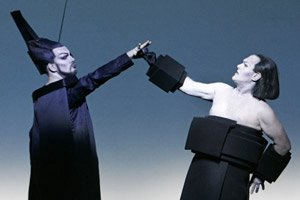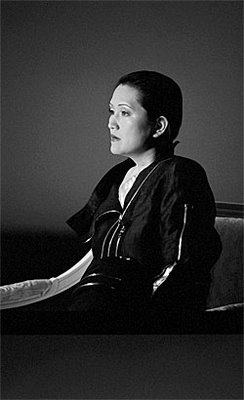The Châtelet Ring, Part 2
 |
The Châtelet Ring, Part 1 (October 25) |
One always encounters a new Ring production with a mixture of apprehension and excitement, like the approach of a maiden voyage. This is especially true since with Bob Wilson, it's a bit of a crap shoot. Because he always creates the same staging, the only thing that matters is seeing if the work will work with his system. With Pelléas, it works. Now, we know that it works with Das Rheingold, too. As if by chance, timeless universes, with very strong symbolism. Because ultimately, to stage Wagner, there are really only two options: a very strong historical setting (no matter what exact date or transposition) or, by contrast, a purity that underscores its universality. Wilson opts for the latter and manages it, like Wieland Wagner before him, through the absence of sets: unburdened by accessories, you can concentrate on the essentials, and that is the lighting, of an unheard of subtlety, that is slipped in between the lines of the text. [...]
The other unknown quantity: Christoph Eschenbach's conducting, five years after the catatastrophe of his only Bayreuth experience. He began very well. The prelude was detailed as it rarely is, and the first scene flowed transparently. But he did not keep his distance. Rather quickly, his venial sins returned, with an often negligent placement of instruments. Why did the woodwinds never manage to attack together with him? Because of a lack of vision in the ensemble, with the winds too strong, which aggravates an unpleasant orchestral arrangement, with all the brass amassed on the right. Still, the Orchestre de Paris was far from unworthy. There was even a string sound of the first rank.
Jorg von Uthmann, Wagner's 'Ring' Features Eschenbach, Singing Zombies in Paris (Bloomberg News, October 26) Caroline Alexander, Festival d’effets spéciaux (Webthea, October 25) Martine D. Mergeay, «La Walkyrie» au Châtelet: inaboutie (La Libre Belgique, October 25) Marie-Aude Roux, Bob Wilson ramène à Paris la folie wagnérienne (Le Monde, October 21) Eric Dahan, Wilson en seigneur de «l'anneau» (Libération, October 22) Elisabeth Lebovici, Un «Ring» où se mesure un metteur en scène (Libération, October 22) Bertrand Dermoncourt, Wagner, seigneur de l'Anneau (L'Express, October 19) Simon Corley, A mi-chemin (ConcertoNet.com, October 21) Simon Corley, Great expectations (ConcertoNet.com, October 19) Joshua Jampol, Clothes that make the character (International Herald Tribune, October 19), on costume designers at Opéra de Paris and the Châtelet |
Robert Wilson's stage adventure, in theater as in opera, is forced to the point of archetypes. The American director has certainly revived a way of staging and imagining lyric drama (he also designs the sets and lighting), before again fixing it in stone: like all artists working in a recognizable style and in a lot of places, he tends toward recycling and cut-and-paste. Much inspired by Japanese theater, reduced, mimed, using both Chinese silhouette and exaggerated lighting, his work is most suited to operas without action, to frescoes, to Greek works like Gluck's Alceste and Orphée et Euridyce, which he staged successfully, six years ago, also at the Théâtre du Châtelet.This fall's performances include only the first two operas, with the other two to be staged in January and the complete cycle of four operas this spring. Marie-Aude Roux reviewed Die Walküre (La beauté vocale et scénique de Mihoko Fujimura domine "La Walkyrie", October 23) for Le Monde. According to her, most of the cast was rather disappointing, as was the conducting of Eschenbach. Only two singers merited her praise (my translation):For this tetralogy, Wilson fans will love to see the cubist kimonos again, the cutting shards of light, hanging screens like the sunshades you see in airplanes, where luminous sunsets seem like an infinite variation on the paintings of Mark Rothko. As for us, we confess we were bored by this imaging of Das Rheingold, as if it had been programmed by a computer direction assistance program on a computer. The conclusion of this scenic festival will tell if Wilson's idea (already premiered at the Zurich Opera) changes at all or persists in this marmoreal and minimalistic chic.
Squarely impressive, Stephen Milling's Hunding is a mean one among the mean. That he is destined to kill Siegmund in the second act does not surprise us, when even Wotan will not interfere. The voice is beautiful, deep, and broad, and the projection powerful, despite a slight lack of tone in the high range. There's a pretty bevvy of valkyries, too, but the heroine of this cast is Mihoko Fujimura's Fricka. Scenic beauty (what sense of line in her persona) and vocal beauty (what support in her line), this Fricka head of household, who phrases Wagner as if she were singing a Lied, is a genial nag. She is also a true grande dame, who demands admiration and shocks. The domestic scene where she reproaches Wotan for his sexual and emotional infidelities is of an incandescent humanity in its tragic pain of wounded pride.Other reviewers are not necessarily as harsh on the cast or as impressed with Fujimura. My general impression from the reviews I have read so far is that the critics are disappointed by the cast and mostly puzzled by Wilson's production. Plácido Domingo will take over the role of Siegmund for the complete production in April.
UPDATE:
See also Alan Riding, Audiences Love a Minimalist 'Ring' Cycle; Critics Aren't Sure (New York Times, November 2). Much to my amusement, Mr. Riding appears to have taken a cue from Ionarts, by quoting a few snippets from reviews in Le Figaro and Le Monde. Or did I get that idea from the New York Times? I don't remember.






















































No comments:
Post a Comment